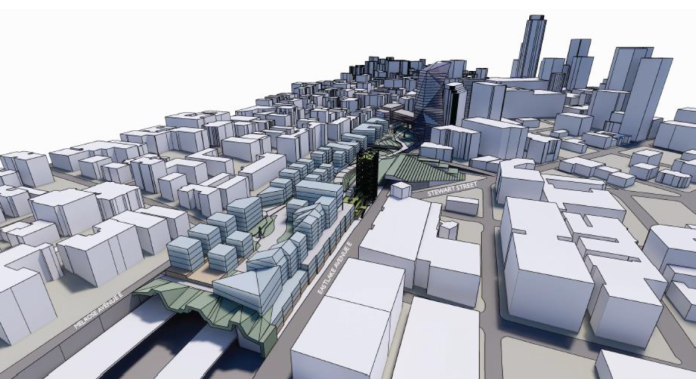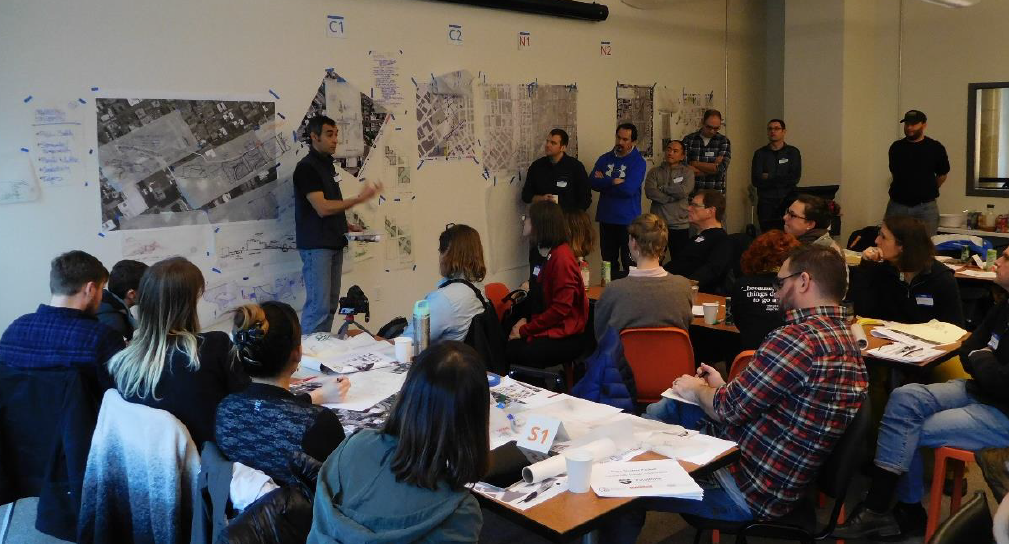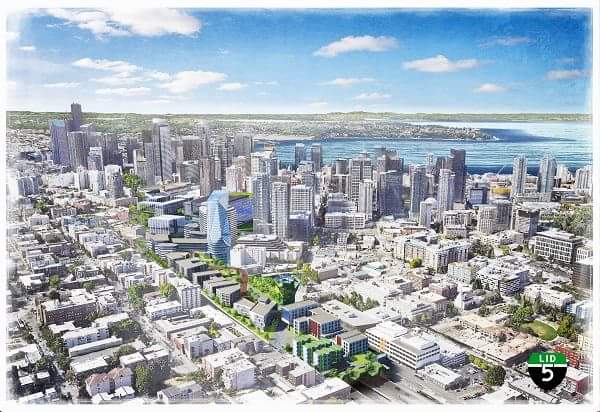
After months of grassroots effort and volunteer engagement, The Central Hills Triangle Collaborative (CHTC) will present its conceptual designs for lidding I-5 in central Seattle tonight (October 3) at 5:30 PM, at Melrose Market Studios. The event is free and open to the public. RSVP here.
The lid designs are the culmination of a series of Collaboratives sponsored by Lid I-5 Steering Committee and the Pike/Pine Urban Neighborhood Council (PPUNC). Kicked off by a charrette at 12th Avenue Arts last March, the sessions were funded by a $48,000 Seattle Department of Neighborhoods Neighborhood Matching Fund grant and fiscal sponsorship from the Seattle Parks Foundation. All events have invited the public to provide ideas and feedback.
The lid study area runs Downtown between Madison Street and Thomas Street, representing approximately 15 acres of developable airspace above the freeway. Each of the five design teams was assigned a subarea and received assistance from an overarching Connections team that provided guidance on pedestrian and bicycle mobility, as well as what potential utility infrastructure the lids could support.
Design teams included volunteer professionals such as architects, landscape architects, urban planners, and engineers, as well as community members representing a variety of interests.
The conceptual designs present options for increasing affordable housing, expanding public open space, and supporting community facilities like schools. As a whole, new developable space created by the lids has the potential to serve a diverse array of public and private functions.

High profile guest speakers at tonight’s event include Seattle City Councilmember Sally Bagshaw, Seattle Office of Planning and Community Development (OPCD) Director Sam Assefa, and Seattle Parks Foundation Executive Director Thatcher Bailey.
This event comes at an important moment in the Lid I-5 campaign. By the end of 2018 Seattle OPCD will release a request for proposals to comprehensively study the engineering, economic, and urban design aspects of lidding I-5. The $1.5 million study, funded by the Washington State Convention Center, was approved by Seattle City Council and will take one year to complete.

The momentum for lidding I-5 comes at a time in which an increasing number of metro areas across the US are looking toward a future in which neighborhoods that were ripped apart by the construction of freeways can restore connections by lidding freeways.
In California, a state synonymous with freeway construction, freeway lids are being proposed and built in cities such as San Francisco, Los Angeles, and Santa Monica.
Given the significant amount of air and noise pollution created by freeways, it is not surprising that cities with high land values and limited developable land, such as Seattle, are reconsidering the role of the freeway in the city’s urban fabric.
“If we take this innovative opportunity suggested by the Lid I-5 campaign, we could have 20 acres of new public land Downtown,” wrote councilmember Sally Bagshaw on her City website. “Land costs are rising as buildable sites diminish. Lidding provides us with a tried-and-true way to create new public space while reducing the noise and pollution which spills into neighborhoods.”
Natalie Bicknell Argerious (she/her) is a reporter and podcast host at The Urbanist. She previously served as managing editor. A passionate urban explorer since childhood, she loves learning how to make cities more inclusive, vibrant, and environmentally resilient. You can often find her wandering around Seattle's Central District and Capitol Hill with her dogs and cat. Email her at natalie [at] theurbanist [dot] org.


